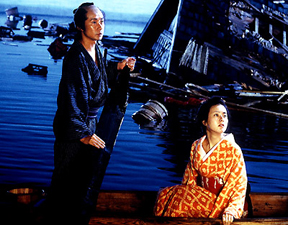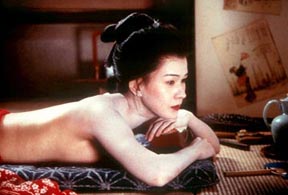Old Stuff
The Sea is Watching (Umi wa miteita, 2002)
Directed by Kei Kumai

As a fan of Japanese Cinema, I was thrilled to see Akira Kurosawa's last screenplay, The Sea Is Watching, brought to the screen by Kei Kumai
The opening crude peasant pageantry of the red light district catches the eye and intrigues the senses before drawing you through the portals of the brothel, Ashi no Ya, and into the lives of the women who survive by their instincts behind their sliding doors.
"The Sea Is Watching" intimately reveals the lives of the women in sparse detail. Their circumstances are explored with a deceptive casualness. The result is a bonding between the audience, and the women of Ahi no Ya, and O-Shin (Nagiko Tohno) in particular. She is an incurable romantic who believes that love will set her free. O-Shin sees herself more as a victim of circumstance than a whore. But this is Japan during the Edo Period (before 1868) where class and gender are often the deciding factors of a woman's fate. No one is more acutely aware than Kikuno (Misa Shimizu) who looks after O-Shin like an older sister. "Let suitors love you but don't fall in love and most important of all, make sure you collect the money for your services," she advises. Unfortunately O-Shin has a tendency to fall in love. She recognizes vulnerability in others and can often bring out the best in them through her empathy. But she is who she is and a disgraced Samurai who showers her with attention is who he is. And no amount of love - mutual or otherwise - can forge a permanent union.
There are others who would love the women of Ashi no Ya like the merchant who loves the head of the house of brothel and Ryosuke (Masatoshi Nagase), the wanderer with a dark secret who drifts into O-Shin's life with the force of a hurricane.

An impending storm parallels the turbulent lives of the women at the brothel. Emotions rise an fall with the ebb and flow of the ocean tide. Two men fight to the death -- one for pride, the other for honor. Nature takes its course and transforms "The Sea Is Watching" into a fairy tale. The bad is washed away. Only goodness and beauty survive. Kikuno sits on a rooftop, the ocean almost at her feet. She unburdens her soul to O-Shin and feels free for the first time in her life. Kikuno is luminescent against a dark night sky brimming with shining stars. She is one with the universe. Part of the Cosmos. Death is just another part of life. She is ready to embrace it -- ready to meet her ancestors -- ready to sacrifice herself so that O-Shin may have the life both have yearned for. And when the end seems near... will a Prince Charming make his appearance? Like I said, "The Sea is Watching" is like a fairy tale and all good fairy tales have happy endings.
The only quibble I have with "The Sea is Watching" is the anachronistic light jazz music that occasionally creeps in. Any complaints are minor when compared to the rest of the director Kei Kumei's artistry. -- Rating: $8.00
A big budget movie based on a screenplay by Akira Kurosawa
Runaway Train (1985) -- Andreis Konchalovsky brings Kurosawa's thrilling tale about an escaped prisoner played by John Voight hiding out on a runaway train doomed to crash in the Alaskan wilderness in the Alaskan. With Eric Roberts and Rebessa De Mornay.
Another Japanese movie with a brothel as its social milieu
Street of Shame (1956) -- Acclaimed director Kenji Mizoguchi's last film still packs an emotional wallop. It's a modern look at the fate of the women of the night who make their living in a whore house called Dreamland. One woman's illusions about happiness when she realizes her suitor is living a fantasy she has bought into.
An American Indie with O-Shin's Prince Charming, Masatoshi Nagasae
Mystery Train (1989) -- Dir. Jim Jarmusch: Nagase is part of an ensemble cast in one of three story lines about foreigners staying in a run down in Memphis, which just happens to be the home of Graceland and Elvis Presley. Hence the title of the movie, one of Elvis's earliest hits.
Greg Murray -- copyright 2003